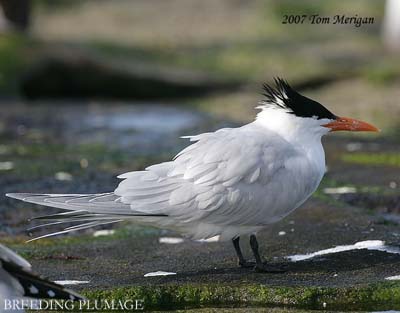
Royal Tern
Thalasseus maximus
Charadriiforme Order – Laridae Family
BIOMETRICS:
Length : 45-51 cm
Wingspan : 100-135 cm
Weight : 320-500 g
LONGEVITY: Up to 17 years
DESCRIPTION:
Royal Tern is a large seabird with very characteristic carrot-shaped orange bill.

Adult in breeding plumage has black crown and elongated feathers on the nape. On the upperparts, mantle and upperwing are very pale grey. Rump and tail are white.
The stout bill is bright orange. Eyes are dark brown. Legs and feet are black.

Adult in non-breeding plumage has white forehead. The crown is white with black streaks. The black colour of the nape extends forwards to the eye.
On the wings, the outer primaries are faintly dusky above. The tail is slightly forked.
Both sexes are similar.
Juvenile resembles adult in basic plumage, but the upperparts shows dark spots and marks. Tail is pale grey with dark tips.
1st summer is much like adult in basic plumage, with dark bar on secondary feathers. Outer primaries and tail are dark-tipped.
2nd summer shows white flecks in the black cap.
They reach their sexual maturity at 3-4 years.
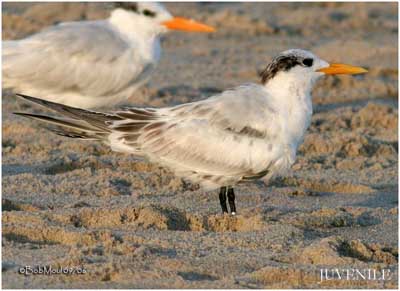
We find two subspecies:
T.m. albididorsalis, from Mauritania to Guinea, and sometimes further south. It winters southwards to Namibia. It has smaller bill.
T.m. maximus, from the North and South American coasts.
VOICE: SOUNDS BY XENO-CANTO
Royal Tern adult gives a shrill, rolling “keer” or “keerlep”, a laughing “keweh-eh” and “kweh-eh-eh”, and also soft piping whistles.
Immature utters a grating “rree-ahk”, and the young birds give high-pitched “see-ip”, and slightly creaky “ahrr”.
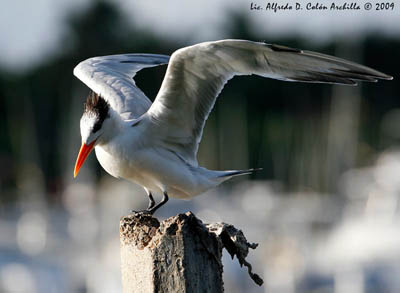
HABITAT:
Royal Tern frequents subtropical and tropical coasts. This species breeds on sandy barrier beaches, salt-marshes islands, coral islands… Many sites are vulnerable to flooding, but the colonies are characterised by inaccessibility, good visibility, and absence of mammal predators. The sites are surrounded by shallow water near the bays.
Royal Tern may be found along estuaries and mangroves where it feeds. After the breeding season, this species frequents coasts, estuaries, harbours and river mouths.
RANGE:
Royal Tern breeds on the Atlantic and Pacific coasts of southern North America and Mexico, and into the Caribbean.
The subspecies T.m. albididorsalis breeds on West African coasts.
The American birds winter southwards to Peru and Argentina.
The African birds move both north and south from the breeding colonies, before to winter southwards to Namibia.
BEHAVIOUR:
Royal Tern feeds mainly on small fish, squid, shrimps and crabs.
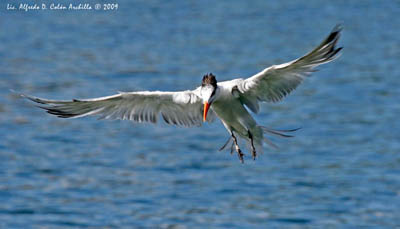
It feeds alone or in small groups, by flying some metres above the surface and dives, but does not submerge.
It also may perform aerial skimming and take offal by surface-dipping. As other seabirds, the Royal Tern sometimes engages in piracy from other terns.
This species usually forages within 100 metres from the coast, but often up to 30-40 km from the colony.
Royal Tern is gregarious, breeding in colonies and roosting in flocks. Colonies may contain hundreds, and sometimes thousands of pairs.
In such huge density, we can find up to 8 nests by square metre. It is also a good protection against aerial predators which are not able to land within the colony.
Royal Tern is territorial and defends its small space by walking or flying towards opponents, by aerial chases, flutter flights, and several kinds of displays with head movements.

Courtship displays can occur both on the ground and in the air. Usually, the male brings back a fish for the female. She may swallow it immediately, but sometimes, she keeps it in the bill during the displays.
Displays include “high-flight” or “fish-flight”. Both birds take off and fly high in the air in tandem, with alternated glides.
When the pair is formed, the displays accelerate and we can observe frequent courtship feeding. Female defends the territory while the male feeds her regularly. Later, copulation follows the fish-transfer.
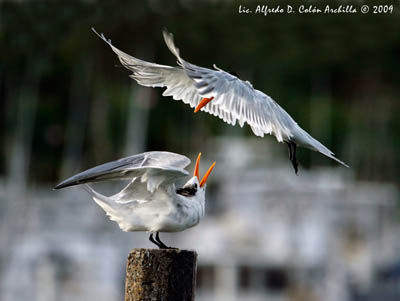
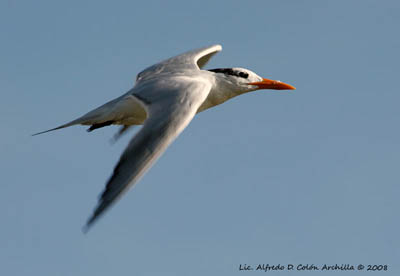
FLIGHT:
Royal Tern flies with steady wing beats. It flies high in the air and dives into the sea for feeding.
REPRODUCTION:
Breeding season varies according to the range.
Royal Tern breeds in huge colonies near other gull’s species. Colonies are very dense with 5 to 8 nests per square metre.
The nest is a scrape in the soil.
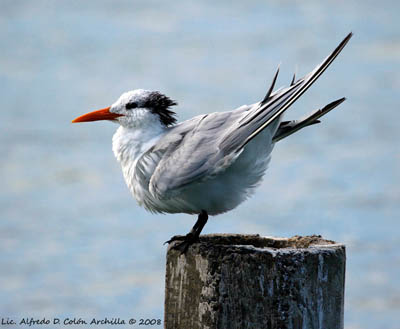
Female lays one egg. Incubation lasts about 25 to 31 days, shared by both adults. Both have brood patches.
At hatching, the chick is greyish or buffy, sometimes with dark spots. Chicks may form crèches. The young fledges about one month after hatching, but it still depends on parents for 5 to 8 months.
DIET:
Royal Tern feeds on small fish (in average 6-7 cm long), squid, shrimps and crabs.
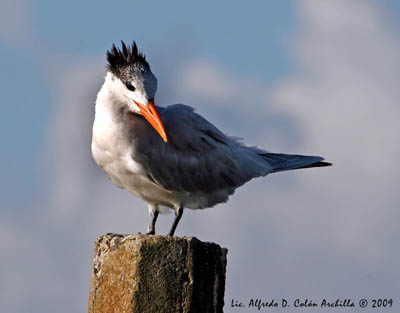
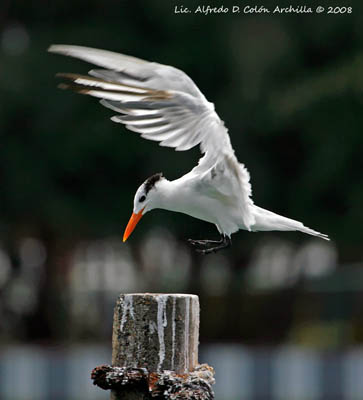
PROTECTION / THREATS / STATUS:
Royal Tern populations decline in some parts of the range. Colonies are vulnerable to flooding and egging. Eggs may be destroyed by sandy crabs. The Common Black-headed Gull takes eggs and chicks.
However, the numbers are very important, and this species is not globally threatened at this moment.
Fr: Sterne royale
All : Königsseeschwalbe
Esp : Charrán Real
Ital: Sterna reale
Nd: Koningsstern
Russe: Королевская крачка
Sd: Kungstärna
Photographs by Alfredo Colón
Puerto Rico Wildlife
Photograph of breeding adult by Tom Merigan
Tom Meriganís Photo Galleries
Photograph of juvenile by Bob Moul
Nature Photography
Text by Nicole Bouglouan
Sources :
HANDBOOK OF THE BIRDS OF THE WORLD Volume 3 by Josep del Hoyo-Andrew Elliott-Jordi Sargatal - Lynx Edicions - ISBN : 8487334202
A GUIDE TO THE BIRDS OF MEXICO AND NORTHERN CENTRAL AMERICA by Steve N. G. Howell, Sophie Webb - Oxford University Press - ISBN: 0198540124
A GUIDE TO THE BIRDS OF COLOMBIA by Steven L. Hilty and William L. Brown - Princeton University Press – ISBN 069108372X
Wikipedia (Wikipedia, The Free Encyclopedia)